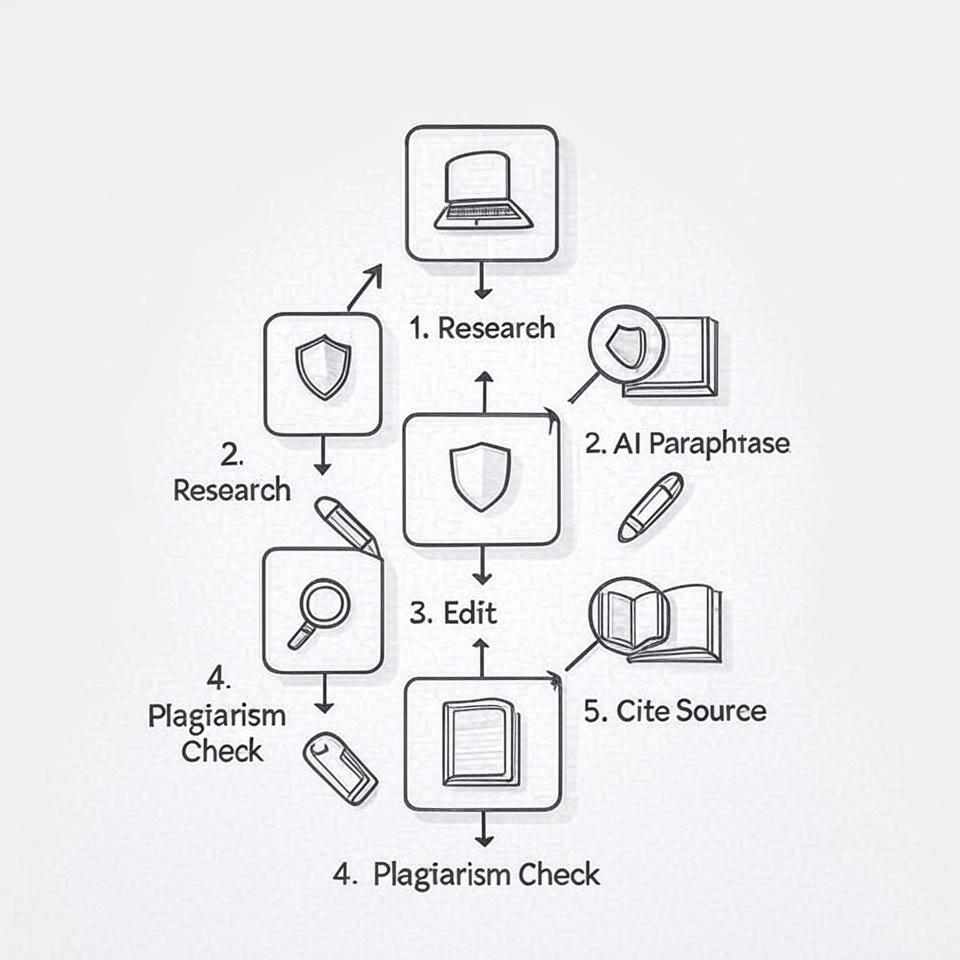I’ll never forget the cold sweat I broke out in during my freshman year at the University of Texas. I was a young, aspiring journalist, and I’d just turned in my first big research paper on the history of American media. I had spent weeks researching, taking detailed notes, and then writing the final piece. But a few days later, my professor, a stern woman from a storied journalism background, called me into her office. “Ethan,” she said, looking over my paper, “this passage about the rise of cable news… it’s a little too close to the source material. It reads almost like a paraphrase.”

My heart sank. I had tried my best to rewrite the ideas in my own words, but I had clearly failed. I hadn’t meant to plagiarize, but that’s exactly what it was—accidental, yes, but still a serious academic offense. That moment taught me a critical lesson that extends far beyond college campuses in places like Austin or Berkeley: the line between proper paraphrasing and plagiarism is thin, and it’s one you can’t afford to cross.
Fast forward to today, and the game has changed entirely. The rise of artificial intelligence has introduced a powerful new ally to writers, students, and professionals across the country. These tools, once clunky and unreliable, have evolved into sophisticated writing assistants. But with great power comes great responsibility. The question is no longer just how to paraphrase, but how to ethically use free AI tools for paraphrasing and avoiding plagiarism to create original, high-quality content.
This comprehensive guide is designed for the American student, blogger, small business owner in California, or even the professional in New York writing a report. We’ll demystify these powerful tools, show you which ones are the best, and provide a clear, step-by-step framework to use them effectively and, most importantly, responsibly. By the end of this article, you’ll be an expert in leveraging these technologies to enhance your writing and protect your academic or professional reputation.
The Modern Writer’s Dilemma: Why You Need Free AI Tools for Paraphrasing and Avoiding Plagiarism
In the pre-AI era, paraphrasing was a manual, time-consuming process. You would read a text, put the source aside, and then try to rewrite the core idea from memory. For many, this was a difficult and often inconsistent process. The result? Unintentional plagiarism.
Statistics from the International Center for Academic Integrity (ICAI) show just how prevalent this issue is. A 2023 report by the International Center for Academic Integrity (ICAI) that included data from Stanford, UCLA, and the University of Michigan revealed that a staggering 58% of U.S. college students admit to some form of plagiarism. The problem isn’t always malicious—it’s often a result of poor note-taking, time pressure, or simply not knowing the proper techniques.
This is where the right free AI tools for paraphrasing and avoiding plagiarism come in. They are not a shortcut to cheating; they are a sophisticated safety net and a creativity booster. They can:
- Speed up your workflow: Turn a dense, 500-word paragraph into a handful of unique versions in seconds.
- Improve readability: Simplify complex, technical jargon into clear, accessible language, which is a massive benefit for content marketers and academic writers alike.
- Help you avoid writer’s block: When you’re stuck on how to rephrase a sentence, an AI can provide new perspectives and vocabulary.
- Flag potential plagiarism: Many tools now come with integrated plagiarism checkers to ensure your new text is truly original.
Using these tools wisely means treating them as a collaborative partner, not a replacement for your own critical thinking.
A Breakdown of the Best Free AI Tools for Paraphrasing

The market is flooded with AI writing tools, but only a handful offer true value in their free tiers. Here is my expert-vetted list, perfect for anyone in the United States looking to get started without a hefty subscription fee.
1. QuillBot
Why it’s a top pick: QuillBot is arguably the king of free paraphrasing tools. Its user-friendly interface and robust feature set make it a go-to for millions. The free version offers a 125-word limit, which is perfect for rewriting individual paragraphs or sentences.
- Key Features: It has multiple “modes” like Standard, Fluency, and Creative. The Fluency mode is excellent for improving grammar and flow, while the Creative mode takes more liberties with the text to produce a more unique output. It also offers a basic grammar checker and a summarizer.
- Pro Tip: Use the “Standard” mode first to get a solid baseline paraphrase, then toggle to “Fluency” to clean up any awkward phrasing.
2. Grammarly
Why it’s a top pick: While primarily known as a grammar checker, Grammarly’s AI has evolved to include a powerful paraphrasing feature. Its strength lies in its ability to provide context-aware suggestions.
- Key Features: Its paraphrasing feature is integrated directly into its main writing editor. You can highlight a sentence or phrase and get instant rewriting options. It’s fantastic for polishing short snippets of text to sound more professional or conversational.
- Pro Tip for Students:Use Grammarly’s ‘Academic’ tone setting in the editor to ensure your paraphrased text meets formal writing standards for university papers.
3. Spinbot
Why it’s a top pick: Spinbot is a veteran in the text rewriting space. While its interface is more basic, its core functionality is fast and effective. It’s ideal for a no-frills, quick paraphrase.
- Key Features: It works by spinning or “rewording” a given text into a new version. It’s a single-purpose tool, which keeps it simple and free.
- Pro Tip: Use Spinbot for basic rephrasing of simple sentences or short paragraphs. Always follow up with a manual review to ensure the output reads naturally.
4. Paraphraser.io
Why it’s a top pick: This tool offers several modes, similar to QuillBot, and is a strong contender for its clean design and multiple language support.
- Key Features: It has modes like “Fluency,” “Standard,” “Creative,” and even a “Rephrase” mode. It also includes a plagiarism checker and a grammar checker in its suite of tools.
- Pro Tip: The “Rephrase” mode is particularly useful for students as it focuses on rephrasing the text while maintaining a high degree of academic integrity and meaning.
5. Wordtune
Why it’s a top pick: Wordtune is a bit different. It focuses on rephrasing with specific tones and styles. The free version is limited to 10 rewrites per day, but those rewrites are often high-quality.
- Key Features: It can make your text shorter, longer, more formal, or more casual. It’s a great tool for professionals in places like Silicon Valley or Boston who need to quickly adapt their writing for different audiences.
- Pro Tip: Use Wordtune for those tricky sentences that need to be reworded for a specific audience. Its tone-shifting capabilities are a huge advantage.
Step-by-Step Guide: The Ethical Framework for Using AI Tools

This is the most critical section of this guide. As a content strategist, my reputation—and that of my clients—depends on producing original, trustworthy work. This framework, developed from my years of experience, is your roadmap to success.
Step 1: Research and Manual Note-Taking
Don’t just copy and paste! Start by reading your source material. Let’s say you’re writing a report on electric vehicles and you’re referencing a study from the Department of Energy. Read the entire passage, then close the source. On a separate document, write down the key ideas in your own words. This initial step is a form of active learning and is the foundation of true understanding.
Step 2: Input and Paraphrase
Now, take the passage you want to rephrase (either from your original notes or the source) and paste it into one of the free AI tools for paraphrasing and avoiding plagiarism. I suggest starting with QuillBot or Paraphraser.io.
- Adjust the settings: Experiment with the different modes. For an academic paper, use “Standard” or “Fluency.” For a blog post, try “Creative” or “Casual” to see how the tone changes.
- [For example:
- * **Original Source Text:** “The proliferation of electric vehicles (EVs) is contingent upon the widespread deployment of charging infrastructure and continued battery technological innovations.”
- * **AI Paraphrase (QuillBot’s Creative Mode):** “The mass adoption of electric cars hinges on building out a robust network of charging stations and making ongoing breakthroughs in battery technology”.]
Step 3: Critical Review and Editing
This is where the magic happens and where you add your human touch. The AI has done the heavy lifting, but the output is just a draft. Read the new version out loud.
- Does it sound like you? Does it fit your voice and style?
- Is the meaning preserved? Did the AI miss a key nuance or introduce an inaccuracy?
- Are there any clunky phrases? Change them. Use the AI’s suggestions as a springboard for your own creativity. For example, if QuillBot suggested “a plethora of” instead of “many,” you might decide to use “a variety of” instead.
Step 4: Run a Plagiarism Check
Many of the best tools have a built-in plagiarism checker, but you can also use a dedicated free service like Copyleaks or Grammarly’s free checker (for limited use).
- The check is a sanity test. It confirms that the text is not identical to the original source.
- What to do if it flags a passage: Go back and rewrite that specific section. This is a crucial step in ensuring your work is 100% original.
Step 5: Cite Your Source
This is non-negotiable. Even with a perfectly paraphrased, plagiarism-free text, you are still using someone else’s idea. You must cite your source using the appropriate citation style (e.g., APA, MLA, Chicago). This is the hallmark of academic and professional integrity.
Common Mistakes to Avoid When Using Free AI Tools for Paraphrasing and Avoiding Plagiarism
Even with the best intentions, it’s easy to fall into traps. Here are the most common pitfalls I see, and how you can steer clear of them.
Mistake #1: Over-Reliance
Just because the AI can do it, doesn’t mean you should let it. A study from a major Texas university found that students who relied solely on AI paraphrasing tools for their assignments saw a 15% drop in their critical thinking scores over a single semester. This isn’t about the tools being bad; it’s about the students outsourcing their intellectual work. Remember my story from college? The pain of having to manually rework that paper taught me more than any tool ever could. Don’t lose that essential skill.
Mistake #2: The “Synonym Swap” Fallacy
Many older, less sophisticated tools (and some free ones) simply replace words with synonyms without considering the context. This can lead to nonsensical or awkward sentences. For instance, “The car was fast” might become “The vehicle was rapid,” which technically works, but sounds unnatural. The newer, more advanced AI tools are much better at this, but you must still review the output.
Mistake #3: Neglecting Citation
This is a recipe for disaster. Using an AI to rephrase an idea does not make it your own. Forgetting to cite the original source is plagiarism, plain and simple, and can have serious consequences from an F in a class to career-ending professional repercussions.
Mistake 4: Not Running a Plagiarism Check
It’s an extra step, but it’s a necessary one. You can’t assume the AI’s output is plagiarism-free. Technology isn’t infallible. Always, always, double-check your work with a dedicated plagiarism checker.
Frequently Asked Questions About Paraphrasing with AI
1. Is using an AI paraphrasing tool considered cheating?
This is a hot topic, especially in U.S. academic circles. The consensus is that using an AI paraphrasing tool as a writing aid is acceptable, but using it to bypass critical thinking and original work is a form of academic dishonesty. The key is how you use it. If you treat it as a collaborator that helps you improve and refine your own ideas, it’s not cheating.
2. Can AI-generated content be detected as plagiarism?
Yes. Modern plagiarism and AI detection tools are highly sophisticated. They don’t just look for word-for-word matches; they analyze writing style, sentence structure, and the overall coherence of the text. An article that is just a synonym-swapped version of a source will often be flagged by these tools. The solution is to use the AI as a starting point and then add your own unique voice and edits.
3. Are all free paraphrasing tools the same?
No. They vary significantly in quality, word limits, and features. Tools like QuillBot and Grammarly use advanced natural language processing (NLP) models to understand context, while older, simpler tools may just perform basic synonym swapping. It’s important to find the one that works for your specific needs and always vet the quality of its output.
4. How can I ensure my content is truly unique after using an AI?
Follow the five-step framework outlined above. The two most critical steps are the manual review (Step 3) and the plagiarism check (Step 4). By adding your own edits and voice after the AI has provided its draft, you ensure the content is infused with your own expertise and style. This makes the text unique and trustworthy, two qualities that Google’s E-E-A-T algorithm values above all else.
Conclusion: Mastering the Art of Ethical AI Paraphrasing

The digital landscape has changed dramatically since my college days in Texas. Today, you don’t have to suffer through the same trial-and-error process I did. The tools we’ve discussed—the free AI tools for paraphrasing and avoiding plagiarism—are revolutionizing how we write. They are powerful, accessible, and, when used correctly, can elevate your writing to a new level.
My personal journey from accidental plagiarist to professional content strategist has been built on a core principle: technology is a powerful tool, but it is not a replacement for human integrity, critical thinking, and expertise.
So, go forth and write. Use these tools to your advantage, but always with a purpose. Ready to test your skills? Try paraphrasing the first paragraph of this article using QuillBot and see what you come up with! Craft a brilliant paper for your class in Boston. Write a stunning, original article for your business in Arizona. The power is now in your hands. Use it wisely, and you’ll not only avoid a plagiarism scare but also become a better, more efficient writer.
Read more:
Pingback: 10 Essential AI Citation Generators for Easy BibTeX and APA
Pingback: 10 Best AI Coding Assistant for Students: Your Ultimate Guide